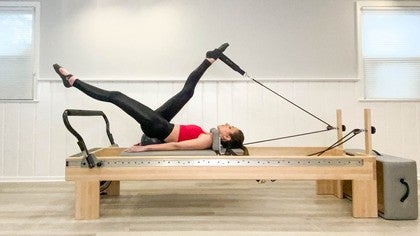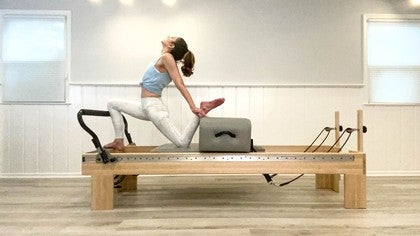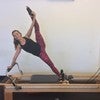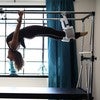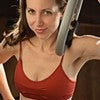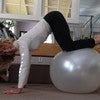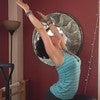Description
About This Video
Transcript
Read Full Transcript
Hi, I'm Mariska, back with another reformer Pilates-ish class. Our action verb for today is stabilize. So it'll be a little balancing, but it'll be more like how our bodies are going to hopefully reflexively stabilize so we don't have to think too much about it when we make ourselves a little bit unbalanced. So I have a ball. Now, pro tip, the less inflated your ball is, the easier things are.
So this one is like, it's inflated, but it could be more inflated. It might be nicer if it was less inflated, but it is what it is. I'm gonna start with two red springs. My foot bar is just in its regular position. And then I have my head rest down because I am going to be doing some bridging, 'cause basically I always do bridging.
So I'm gonna start by lying down on my back, and then I'm gonna lift my hips up, and then I'm gonna place the ball so it's basically underneath my sacrum. And this should be pretty comfortable, except notice that you can kind of roll a little bit from side to side, which is what's gonna make this a little bit more interesting. So start with your heels together, toes apart. You're just gonna press yourself out, bend to come in. Push out, and in.
Push out, and in. So this should be relatively easy. We're gonna obviously take things up a notch as the class goes on. And the first thing we're going to do is take this into a single leg variation. So I'm gonna come to parallel.
I'm gonna come on to sort of where my heel and arch come together. I'm just gonna lift one leg up, and then I'm gonna push out. And this is relatively still, not that complicated. So I'm gonna see if I lift my right arm up to the ceiling, kind of how does that feel? 'Cause that means I have a little less something to hold onto.
Now, when I push out on this next one, I wanna take my right arm slightly to the right, and my left leg slightly to the left. So I'm going out and in, and I'll do eight of these. Two, three four, five, six, seven, and eight. Right arm comes down, left leg comes down. First, I just get my right leg up, and then I'm just gonna do a couple presses out, just with my right leg lifted.
Then I'm gonna lift my left arm, kind of taking it up a notch from there. And then just think, try not to fall off the machine. Then I'm gonna open my arm and my leg a little bit and come back. I had a student say that I do some crazy things on the machines, and wasn't I scared of doing them? And I was like, I just dissociate my feelings, so I don't tend to feel afraid of the reformer.
I probably should have more fear in my life, but that's what therapy is for. We'll go ahead and do a couple more, and then last one. And then we're gonna come and bring your foot down. We're not done with doing stuff where we're propped up like this. Let's go ahead, we'll do one little quick thing, just 'cause it's kind of feels good.
So your legs are up and you're just gonna roll a little bit to one side and then back to center. And then you roll a little bit to the other side and back to center. And obviously, you don't wanna roll so far that you end up off the ball and the ball goes flying across the room. But I'm not watching you, and probably no one else is watching you either, so if that happens, just pick the ball up and keep going. Last one like this.
And then I'm gonna place my feet back. I'm gonna lift my hips up, lower down, and I'll place the ball in between my knees. From there, I'm gonna tuck my pelvis, lift my hips up, and then lower back down. So this is not particularly challenging. It's not really different from doing a regular bridge, but on this bridge, let's stay up, and then we're gonna extend your left leg straight.
We're gonna do eight squeezes. Two, three, four, five, six, seven, and eight. That foot can come down. Other leg extends. This is definitely my harder side.
Do eight. That was two, then three, four, five, six, seven, and eight. I'm gonna lower my feet. Lift my hips up just a little bit more. Lower down slowly, bone by bone.
I would love for a teacher to pop in right now and change my springs for me. However, I've got no one, so it's gonna be just me. I'm losing one spring. I'm gonna place the ball back between my knees, and I'm just gonna grab the right side strap. I'm gonna lift my legs up, and I'm just gonna press my right arm down and lift up.
So when you do stuff that's asymmetrical, or I had a client once that called it ass-symmetrical. He didn't ever want anything ass-symmetrical in his stuff. But if you're doing things asymmetrically, it's going to make you have to stabilize to keep your body from being pulled in the direction that the weight's in. We'll do a couple more. Last one like this.
Go ahead and lower that strap. Lift the other strap. And then we'll start, in the smaller, we'll start pressing down and lifting up roughly eight times. And it's totally normal for one side to be easier than the other side. This is definitely the side that things want to twist on, But I am thinking, just don't do that.
We'll do four more. One, two, three, and four. I promised you we were gonna sit on the ball again, and we're gonna do that now. So we're gonna take the ball. You're gonna lift your hips up.
We're coming back basically into that start position we were in. We're gonna take just the right strap, place it on your right foot. And then you can start with your right leg, lift it up towards the center. Your left leg can just kind of be wherever. And then you're gonna start by pressing down and lifting up.
Pressing down and lifting up. And I actually like this almost better than just doing it regular, because it does feel nice to have that support on your lower back. And if you feel really unstable, you can always hold on to the posts, or you can hold onto the shoulder rest. Now we're gonna take this into a circle, but it's not gonna be a circle, like a half circle. So you're gonna down out a little bit around and up.
So how far out you go is going to be based on how far you feel like you can control that movement. And then I think it's actually harder to go the opposite direction, where you start up and then you go out first, down and up. We'll do, I don't know, three more. One, two, and three. Now we're gonna take your left leg, extend it out.
Reach your left leg up as you push your right leg down, and then we're gonna helicopter your legs around. Now you push your right leg down as you lift your left leg up. Reach your right leg up as your left leg goes down, and then you helicopter it around so they switch. So it's basically scissor, scissor, helicopter, scissor, scissor, helicopter. We'll do one more round, scissor, scissor, and helicopter.
You have your left foot just finding the foot bar. So you can take the strap off of your right foot, hang it up. And then you're gonna take the left strap. You'll put the left strap on your foot. You can just go ahead and just bend your right knee.
And you're just gonna start by lifting and lowering your left leg. And if you have a functioning neurological system, all this stabilization should be happening without you having to really think about it. If you have some sort of neurological deficit, you might actually lose some reflex stabilization, but that can actually be retrained, which is good news for if you ever have a neurological injury or illness. But one of the main ways you retrain these things is you retrain stabilization by doing exercises that require stabilization. Now you'll take your leg down.
We're gonna do that out and up. And notice it's not going out that far. So we did about five each direction. There's three, four, and five. And then we start at the top.
We go out, and two, three, four, and last one. And then you're gonna extend your leg up as you extend your right leg out. Now we're gonna lift your right leg up as you push your left leg down. You're gonna circle your legs away from each other. And then you're gonna do a scissor.
So right leg up, left leg up, helicopter. Left leg up, right leg up, helicopter. Let's do three more. Down, and up, and helicopter. Down, and up, and helicopter.
And last one, down, and up, and helicopter. Go ahead and you're gonna lower your right leg to the foot bar. Take the strap off of your left foot. And then you can lift your hips up, and then you're gonna remove the ball. And then go ahead and make your way all the way up from there.
So I always have a, I'm told, a resting bitch face when I work out. Probably have it just during my regular day-to-day life as well, but I definitely have it when I work out, if I'm having to concentrate on not falling off of something. So that was certainly the situation in that case. I think a red is going to be hard enough, but doable. So I just wanna turn around, and I'm gonna make this ball like a little bit of a back rest.
But it's a little challenging to get into without losing the ball, so I kind of hold onto the ball 'cause it's like right at the edge until I'm ready to kind of lean back into it. So from there, we're just gonna take your arms and you're gonna press them down. We say, if you wanna feel your abs, just do this. Press down. And I'm cheating it a little bit on the weight by using the bigger of the two loops if you've got two loops.
I like having two loops on the straps because it's really easy to just make an adjustment for weight by making it a little bit lighter or a little bit heavier. So now I'm gonna take one arm and I'm just gonna rotate. So the other arms is gonna go slack. And then I'll pull back to center. And then let's twist, rotate, and pull back to center.
Twist, rotate, and pull back to center. Twist, and back to center. Twist, and center. After this one, we got one more each side. Twist right, and center.
Twist left, and center. So from there, we'll just do a couple more where we push back and forward. I'm going back sort of at an angle. We'll do three more. One, two, and three.
We'll go ahead and hang this up. I'm gonna take the ball. I'm gonna say goodbye to it. It's a ball. It can very easily just roll off of the screen.
Who knows, it might come back, might decide to come back. If it comes back, it might mean we want to use it again, but I'm gonna say that's where it is. I'm gonna go ahead and change my spring to one blue spring. And I want it to be lighter for the second exercise. The first exercise, you could probably keep it on a red, but I'm gonna sit cross-legged, and I don't wanna be touching the shoulder rest.
I think a lot of times, when we're doing seated exercises, we touch the shoulder rest because we're like, oh, that would make it a lot easier if we're touching the shoulder rest, but I don't necessarily want to do that. So I'm gonna start by bringing my hands so they're kind of behind my head, and then I'm going to lean over a little bit and touch my right elbow to my left, or my right elbow to my right knee, and then back to center. And then lean over to the side. And one strap might go slack, and one strap might pick up more of the weight, and that's fine. So do a little side bend.
And what you wanna look at is what your knees are doing. And what you don't want them to do is when you start to move, you don't want your knees to start lifting up, because that means that you are trying to get stability where we don't necessarily need to be finding it. Although maybe that is where you need to be finding it today. We'll go ahead and come up to seated. Now I'm gonna hang up one of the straps, and I'm gonna try again to keep my knees really quiet as I just take one arm and press forward.
And we'll do five of these. I think that was four, and five. Now the hard one is to let your arm go out a little bit and pull it in. I don't know that I could do a full tree hug with a straight arm, so I'm just going out as far as I feel like I can bring it back. Do two more.
And last one. And then I'll go ahead and hang that up. So left arm has five presses, three, four, and five. And then we open and close. And I don't know if you notice, my legs wanted to slide there.
And I don't want them to do that, so I might have to make my, since they smallen my range of motion, which is a word I just made up just now. Do two more, or one more, I think. And then we'll go ahead and lower that all the way back down. Let's go ahead and come to one red spring. You're just gonna kind of flip your legs around.
We're gonna do kind of a variation of a knee stretch, except we're only gonna use one arm, which is why I have it on such a lightweight. If you want it to be on a heavier weight, knock yourself out. So your arms are on the foot bar. You're gonna tuck your pelvis under. One arm stays on, other hand goes behind your back.
You're out, and in eight times. Two, three, four, five, six, seven, and eight. Other hand goes on, other hand behind your back for eight. Two, three, four, five, six, seven, and eight. And then you can go ahead and bring your hands on.
You can just extend your spines. You're kind of coming into a down stretch. We're gonna push out a little bit. And so we're not gonna go super far, because we're also gonna do this with one arm. Out, and in.
Now you could take your arm behind your back again, out and in. And you might notice your hamstrings become a stabilizer here by kicking in. And then we'll do three the other side. Out and in. This side does not like this exercise.
Two, and three. And then come all the way in. And then just go ahead, we'll take a quick little child's pose so you can kind of press back from there. My shoulder just popped. Again, I think that's an age thing, not necessarily a, it's definitely not a shoulder injury thing.
It's completely still fine. Let's go ahead from there and we're going to, let's keep it on the red spring. We're gonna stand kind of close to the front. And what I want to do is, let's be, we can be in a Pilates V, or we could be parallel. I think I wanna be parallel right now.
So what I wanna do is not move away, I don't wanna push out, but I'm only on one red, so I'm gonna lift up to my tiptoes. I'm gonna lower down into sort of a squat, and then think coming into a forward fold, dropping my heels down. Lift up, lower down, so I'm sitting on my heels. Lift up, lower my hips. Tiptoes to squat, lift up to lower.
Tiptoes to squat, lift up to lower. And now we're gonna go into the squat. From the squat, you're gonna press your legs out a little bit and then extend your spine. And you're gonna bend your knees in a lot, and push. And it's heavy, so we're going to stay in the forward part of this push.
Hello, quads. Out and in. Out and in. Come in, sit down on your heels, hopefully with less noise than I just made. And then you'll stand up, and then lower your heels all the way down.
Now, since my foot bar doesn't move, I can go ahead and kind of hang back into a stretch, which feels really nice. Obviously, if your foot bar moves, don't do that. That seems like that would be a very not great idea. I'm gonna lower my foot bar down a little bit from where it is. I might wanna go a little bit more.
I might go one more. So I'm gonna go down to about there. Now, I'm gonna start kind of scooted over to the side, because I want my left foot to be able to be up in the air and my right foot to be up against the shoulder rest. And I'm gonna bring my right hand onto the foot bar and my left hand onto the carriage. And then I'm gonna extend my left leg back.
And I'm just gonna push out and in, out and in, out and in, out and in. We'll do four more. Two, three, and four. We're gonna come in to the stopper, open your left hip. This is where the stabilizing part comes in.
So we've got our hip open. We're gonna see if we can lift our arm open. We're just hoping for the best here. Find a lot of length. Smile through the fear.
And then we'll go ahead and come down, and we'll scoot over to the other side. That was my good side. It's always sometimes good to start on your good side. Sometimes it's a little worrisome to start on your good side, knowing you have your not good side left to go. So I have my left knee scooted out so I'm on the right side of the reformer.
My left hand is on the foot bar. My right hand is on the frame. We're gonna do eight presses. Two, three, four, five, six, seven, and eight. We'll come in.
We're gonna shift, I'm gonna shift forward a little bit. And then I'm going to hold onto the foot bar here to open my hip, just to try to find my balance. And then, I have a wall there, super useful, and then I'll lift up, but I still have the wall there. Lift up, and then lower back down. Clearly, that is not my good balance side.
Luckily, I had a wall there. If I didn't have a wall there, I'd probably just step my foot down to the floor. So I'm gonna go ahead and grab the box, and I'm gonna put it on long way. And then let's come to a blue spring. And we're gonna go ahead and lift the foot bar back up to its normal position.
So long box means box long way. I always love when you first start teaching, and you tell people to get the long box, or you tell people to get the short boxes, if they're two different things, and then people just look at you like, "Why are you insane? Where is this equipment that you're asking me to go fetch?" So you're gonna have the box on long way. And we're gonna start facing the foot bar on your stomach. And it's reasonably light, because we're gonna be doing some single arm stuff.
So take your left arm and just kind of wrap it around the box. And your right hand can be either elbow down, which will be a little more tricep, or elbow up, which would be still tricep, but it's a little less intense. So I'm gonna split the difference. So I'm gonna push out. At the same time as I push out, I'm gonna lift my left leg, and then come in.
Push out, lift my left leg, and come in. The magic number is eight today. Three, four, five, six, seven, and eight. And I'm gonna switch. So now my left hand is on, my right hand is wrapped around, push out, lift my right leg up.
And here's two, three. And you're trying not to have your torso twist here. So you want your shoulder blades to sort of stay where they are. So sometimes when people do this exercise, they do kind of wonky stuff to try to find their stability. Do four more.
One, two, three, and four. And then we'll go ahead and we're gonna slide off to one side. I want the foot bar just to be a little bit lower. Don't think I'm gonna run into it, but I don't wanna run into it. So I'm just gonna lower it down, teensy bit from where it is.
And then I'm gonna come to a quadruped facing the other direction. So the hfirst thing I'm going to do is grab the closer to the camera-side straps, that's the right strap for me. And then I'm gonna be in a quadruped here. And I'm just gonna take my right arm, and I'm just gonna pull back and forward, and I'll do eight of these. Two, three, four, five, six, seven, and eight.
Now I'm gonna hang this up for just a brief moment. Where I want my left knee to be is actually more to the center. My hands are still gonna be able to be where they are. I'm gonna grab the strap. And then I usually like to sit back a little bit, just so I don't feel like I'm being pulled forward.
And then I'm gonna pull it and put it on my foot. So from here, I'm gonna take my right leg down towards the floor. I'm gonna pull up and down eight times. Two, three, four, five, six, seven, and last one like this, eight, you can just kind of hold it up. And then we're just gonna do a little hold.
If you wanted to extend your opposite arm, you could. I don't actually want to do that. That does not seem like a good idea for me right now, so I'm not doing it. But if you want to, you can. Just know that your box is right there for you to go ahead and grab it.
And then I'm gonna take this leg and I'm gonna bend it, and I'm gonna come out of it the way I came into it. So I'm gonna kind of sit back, grab hold of the strap, and then I just slowly let my arm extend so that I can hang it back up. I'm gonna come back to sort of square on the box so I can grab hold of the opposite side strap. And I've got eight pulls. And I always say, any of these times you're doing exercises like this, you are getting an oblique workout.
If you are doing something where you're pulling weight on one side, your obliques are acting as stabilizers, which is sometimes even more of an awesome oblique exercise than doing straight up obliques. Do a couple more. And then I'm gonna sit. First, I'm gonna move my left knee so it's a little bit more, or my right knee, sorry, so it's a little bit more towards the middle. I sit myself back so I can grab this strap, and then just pull it so it's hooked on my foot.
Now, the reason I walked my right knee to the middle is because it's just easier not to catch your leg on the box. So I'm gonna pull back eight times. One, two, almost took the strap off my foot there, it was a little too close, three, four, five, six, seven, and eight. So I can go and just hold it there. Again, if you wanted to take your arm off, you can.
Again, I just don't feel like I want to. And then we're getting out of it the same way we got into it. So bend your knee, sit your weight back, grab hold of the strap, give it a little pull. And then you can go ahead and have the strap come in. I'm actually gonna take the box.
I'm gonna change my spring to a blue that's a little bit higher. You can choose a red, you can choose a yellow. You can kind of go with whatever you want. I'm gonna take the box to the side of the reformer. So it's gonna be basically on the floor.
I might scoot it back a smidge. And then from there, I'm gonna come into a quadruped on the box again. So before, we were doing a pulling motion. Now we're gonna do a pushing motion. So your hand is on the shoulder rest and you're gonna push out.
And now here, I do want to do opposite leg up. And then when I bring my arm in, I'm gonna lower that foot to the floor. Push, lift, and in. Push lift, bring it back in. Push, lift, bring it back in.
I'm gonna do a couple more. Push lift, bring it back in. Okay, so on this next one, when you let your arm bend, you're gonna bend your knee and push. And we'll do eight of these. Two, three, four, five, six, seven, and eight.
And then go ahead, you'll bring your knee in. Go ahead and bring the carriage in. We're gonna take the box. This is half the workout is just picking the box up and moving it around. And we're gonna take it to the other side.
And we'll repeat that exercise. Full snug on this side in my studio. So (box thuds) excuse the noise. So when it comes to a quadruped position, this time, I'm going to take my left leg back, my right arm pushes forward. And then as I come in, my left leg lowers down.
Push out, and we'll do eight of these. Here's three, four, five, six, seven, and eight. Eight more where we have a bend, push. Two, three, four, five, six, seven, and eight. We'll go ahead and lower your leg down.
Let the reformer come in. I'm gonna go ahead and lift the foot bar back up to its normal heights. And then I'm gonna take the box and place the box, I'll leave the box here actually. I'm gonna place the box here because I'm gonna grab it shortly for one last, for our stretch. I just wanna do a lunge stretch in kind of a different way.
But first, I wanna do a little bit of a mermaid stretch, just because we did work our obliques a lot. I'm going for the most basic simple one, which is to sit in a pretzel position, bring your hand down. We're gonna reach out, reach towards the foot bar, reach back, and lift up. We'll do three like this. Reach, twist, and up.
Reach, twist, and up. And then I love the reach, twist, and stay there, widen your hands, we're gonna lift up. This is like the most satisfying stretch in all of Pilates, in my opinion, and reach out. And we'll do five of these, because these are better than the other ones, so we should spend more time enjoying this. Out, and in.
Out, and in. We'll do two more, reach out, pull in. And reach out, and pull in. Just lift your knees up and around to turn to the other side. It's kind of magical how that works.
Your left hand is down, we're gonna reach out, twist, untwist, lift up, reach out, twist, untwist, and up, here's three. And then on the next one, we're gonna widen your hand. So hand down, other hand down, reach out, and then pull to come in. Four more. Out, and in.
Three, four, and last one is five. You can keep it on a red. I think I wanna change it to a blue. And then I would put the box on. And I wanna do a lunge stretch with the box on the reformer, because I think that, I just kind of like something that you can do here.
You do have to have the flexibility to be able to get your leg up this high. If you don't, then I would say, just do it like regular, where you bring your foot up against the shoulder rest. But I'm gonna bring the top of my leg onto the box. So I'm just pushing out a little bit. But actually, what I wanna do here is I wanna work more on rotating my hip open and closed.
Rotate open, and closed, which to me feels really good. We'll do two more. And last one like this. And then if you want to, there's really probably not a lot of pushing back. You can push our right leg kind of straight, but we're so high with our back leg that I'm just working on getting my chest maybe a little bit more lifted and then tucking my hips under to try to get more of like a hip flexor stretch on this side.
But again, if this does not feel good for you, then skip it. And then we'll work our way around to the opposite side. Now, this is my tighter hip flexor, so might not get as deep in the stretch on this side. But try to keep your hips square to the front to start, and then you rotate your hip open and closed. Rotate open, and closed, a couple more.
Last two. And last one. And then lift your chest up. Try to tuck your pelvis under more. You should really feel kind of a big stretch in the front of your hip.
And then you can make your way off from there. If there's any other stretches that you want to take, or your body thinks you should be taking, go ahead and take this.
Pilates-Ish with Mariska: On the Reformer
Comments
You need to be a subscriber to post a comment.
Please Log In or Create an Account to start your free trial.
